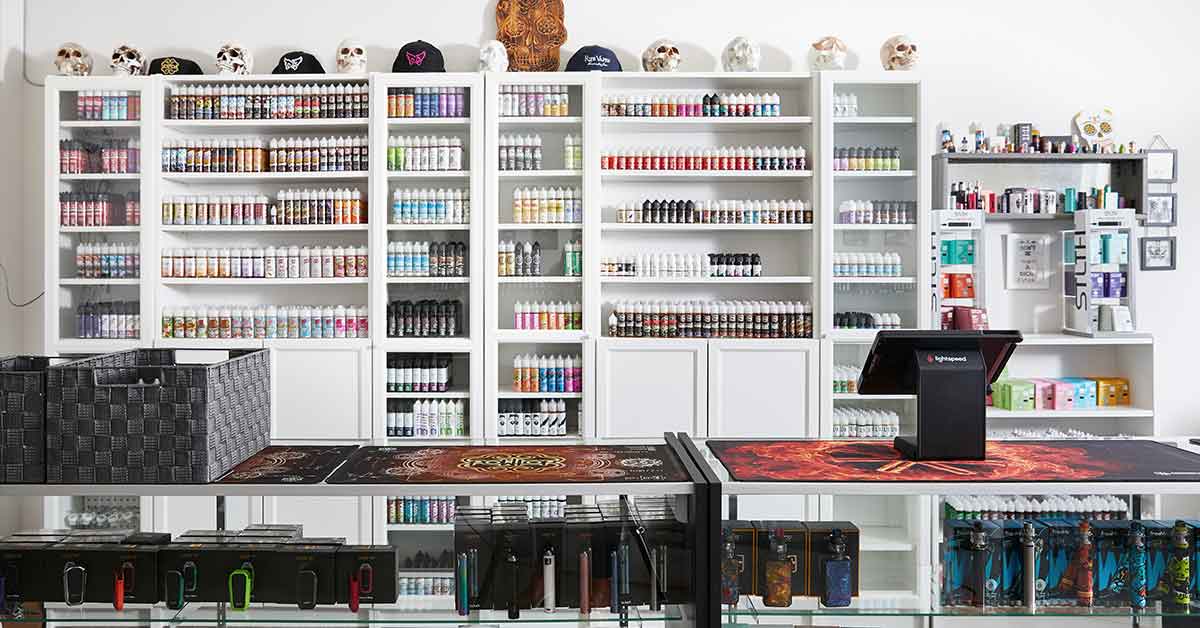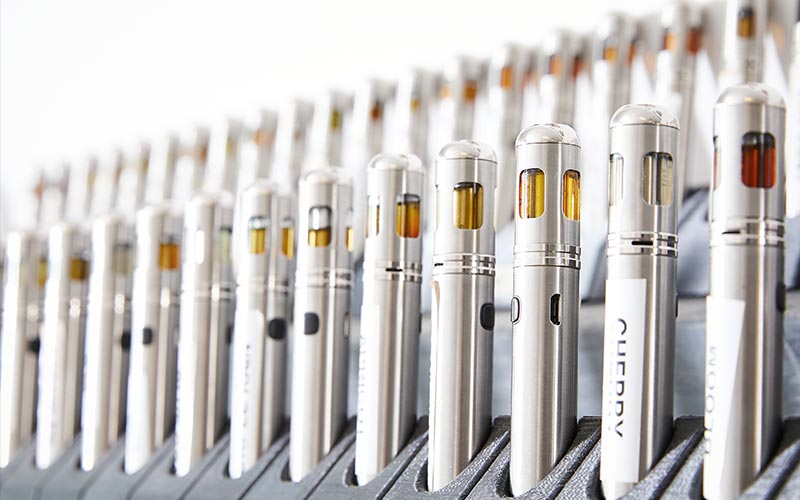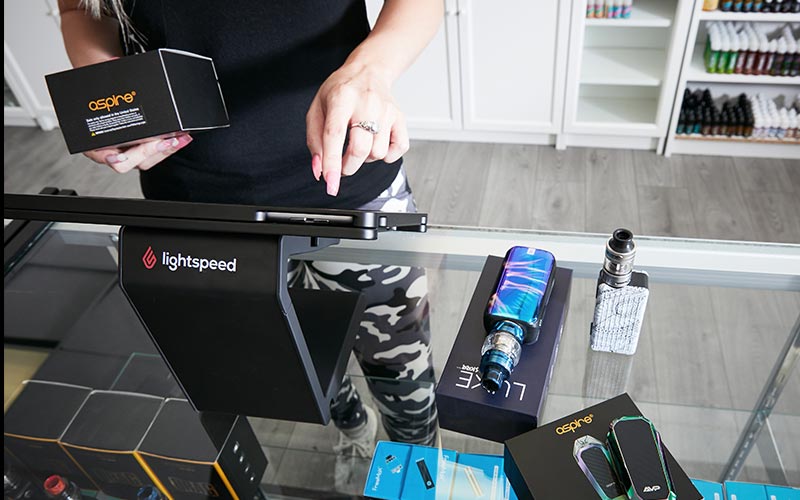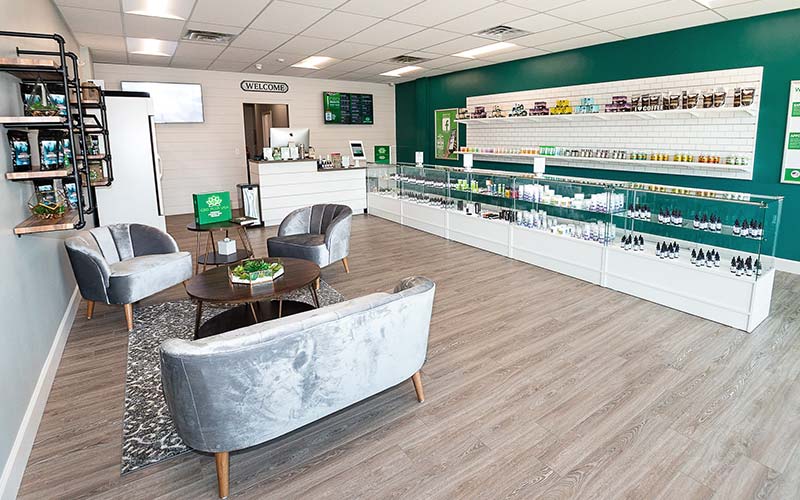
Thinking of starting a vape shop? Like most businesses, embarking on the adventure of opening a vape store is no easy task. But there are several key aspects that, if addressed early, will set your business up for success in the future. Here are nine key things needed to reach vaping victory.
- Prepare a business plan
- Familiarize yourself with local regulations
- Choose a location
- Assess your startup costs
- Find reliable suppliers and order quality inventory
- Choose a vape-friendly POS system
- Build a smoking social media presence
- Hire the right employees and prioritize customer service
- Create a welcoming atmosphere
- Understand the health implications of vaping
- Develop a marketing strategy that complies with advertising regulations
- Emphasize the importance of age verification and legal compliance to employees
- Explore ecommerce and online sales opportunities
- Implement effective inventory management techniques
- Consider diversifying product offerings
- Focus on building a community around your brand
- Understand the importance of sustainability and eco-friendly practices
Create the right social media strategy for your business
With so many social media platforms, it can be tricky to know which ones are worth building. Download our free guide to build a strategy that targets the right audience to bring in sales.
1. Prepare a business plan
Before you open your vape shop, it’s important to take the time to write a business plan. A business plan is a write-up of your business goals and how you intend to achieve them. Your plan will help you assess your business’s purpose and serve as a guide for staying on track once you’ve opened. Most business plans include information about your company and brand, an analysis of your competitors, your marketing plans and your financial projections.
Don’t worry, writing a business plan doesn’t require an MBA. You can find many standardized business plan templates with a quick Google search to help you get started.
2. Familiarize yourself with local regulations
One major area where vape shops differ from a traditional retail business is the licenses and legal requirements needed to set up shop. In general, laws around the sale and use of tobacco also apply to vape and e-cigarettes. However, each state, and even some localities within states have their own regulations. It’s important to check with your local authorities to understand the laws you’ll need to comply with and licenses you’ll need to acquire. Accounting for this in your business plan can save you time and prevent major or legal trouble down the line.
| License Type | Description | Why It’s Needed |
| Business license | A basic permit issued by the local government to operate a business within a certain jurisdiction. | Required for legally operating any business, including vape shops. |
| Retail tobacco license | A specific license for businesses that sell tobacco products, including e-cigarettes and vapes. | Often mandatory for selling vape products; regulations vary by location. |
| Seller’s permit | A state-issued license allowing the collection of sales tax on products sold. | Required for retail businesses to legally sell products and collect sales tax. |
| Zoning permit | Permission to use a property for commercial retail purposes according to local zoning laws. | Ensures the vape shop’s location complies with municipal zoning regulations. Typically the concern of the building owner/landlord. |

3. Choose a location
Like most retail businesses starting out, you want to choose a location for your vape shop with plenty of traffic and visibility, parking and an inviting storefront. Vaping is a hot trend: the industry was valued at $6.09 billion USD in 2020 and is projected to grow by 27% by 2028. Many entrepreneurs are looking to get in on the action, which makes your location that much more important.
As vaping has become more mainstream, it’s also made its way into gas stations and convenience stores, so you may be competing with them, too. Taking the time to perform a competitive analysis, as well as studying the available commercial real estate to identify the optimal location, could be the key to your success or failure.
4. Assess your startup costs
You’ll also want to have a firm grasp on the startup costs associated with opening a vape shop. The costs of starting a vape shop can vary widely, but here are the basic expenses you’ll need to account for before opening your doors:
- Renting a retail storefront
- Fees for obtaining licenses and permits
- Enrolling in a business insurance plan
- Payroll and tax costs, especially if plan to you hire employees
- Initial inventory
- Equipment for running your business, such as retail shelving, counter space and a POS system
5. Find reliable suppliers and order quality inventory
It’s crucial to find a reputable, trustworthy supplier that carries products your customers will love. The last thing you want or need is for your supplier to either run out of the items you sell or for them to be unreliable. To find a supplier to work with, try doing some preliminary research online or ask around at your favorite vapor shops.
When it comes to ordering inventory, make sure that you’re not just choosing products that you’d want to use. Though you serve a niche community, you want to make sure that you appeal to the largest number of people possible. Do a little market research and ask around. What are vapers looking for? What do they feel vape shops are currently missing and what would they be excited to see at a new shop?
For beginners, you’ll want to sell at least one variety of rechargeable e-cigarette or an e-cigarette starter kit. For more experienced vapers, you’ll want to offer several vape kits that allow for customization. Lastly, be sure to stock a variety of vape supplies like batteries, mods and perhaps most importantly, many varieties of vape liquid or juice.
6. Choose a vape-friendly POS system
Purchasing a vape POS system is one of the most important moves you can make when starting any business. A good retail POS system will not only provide a customer-friendly experience at your checkout counter, but also will allow you to capture customer information, optimize staffing, and manage and reorder your inventory more efficiently. Starting a business is time-consuming, but using a POS system helps you save time so that you can focus on the aspects of your business that matter most. For your vape shop, you’ll want to look for a POS system that has built-in RACS compliance, as well as age and quantity restrictions.
“Without the Lightspeed platform enabling [data collection] for us, none of the customer engagement and education that we’ve been able to accomplish through email marketing over the past six months would have been possible. The email marketing and the engagement has improved customer retention and has helped us grow revenue and stores.”
Wilfredo Rodriguez, CFO, Sunmed/Your CBD Store

7. Build a smokin’ social media presence
Social media is critical for any retail business. It helps drive traffic to your store and is integral in building a strong and personable brand. But since search engines such as Google and Bing don’t allow vape stores to create ads, this makes a strong social media strategy crucial to starting and running a successful business. It also goes hand-in-hand with the community of vapers you’ll be cultivating.
Ideally, you want your social channels to attract new customers and keep returning customers up-to-date on promotions and events at your store. To make your small business social media social media strategy most effective, you’ll need to assess which social media platforms are best for business.
8. Hire the right employees and prioritize customer service
You might find that you need help running and managing your vape shop. If so, you’ll need to find the right staff. In the U.S., vape store employees earn an average of $13 per hour, but be sure to check your local guidelines to find up-to-date minimum wage figures. Once you’ve assessed how many employees you’d like to hire, post a job advertisement online or in your community to get the word out.
As far as customer service goes, your approach must be twofold: 1) you’ll need to provide advice and product recommendations that meet your customers’ individual needs and 2) you’ll need to deliver excellent customer service and education consistently.
Educating your customers about vaping products, their safe use and maintenance is essential. That means being able to help new vapers pick out the starter kit they need just as well as you can talk through the intricacies of a new vape pen or vape mod with an experienced user. Employees should be able to provide clear instructions, safety guidelines and troubleshooting tips with every purchase. Consider creating online resources, such as blogs or tutorial videos, to support them.
Like a sommelier, employees also need to be able to speak to the nuances of the thousands of flavor and nicotine strength combinations of vape juice.
As far as customer service and customer relationship management, you’ll want to develop policies that make sense for your business, but here are a few general questions you’ll want to answer:
- How will employees greet and interact with shoppers in-store?
- How will you handle returns or exchanges?
- How will you handle disputes and angry shoppers?
- Will you order products that you don’t carry in-store for customers?
- What programs will you put in place to develop customer satisfaction and loyalty?
Once you feel like you’re able to address these questions, make sure to put your policies in writing and train your staff accordingly. While a lot of customer service may seem like common sense, people will surprise you in the heat of the moment. The best thing you can do to combat this is to regularly revisit customer service policies with your team and practice roleplaying as needed.
9. Create a welcoming atmosphere
The atmosphere of your store is a significant way to differentiate yourself and get a leg up on the competition. This means cultivating an environment that encourages customers to safely spend more time in your store. To help you achieve that goal, consider adding the following elements to your shop to create a comfortable, inviting vaper lounge:
- Comfy couches and chairs
- Televisions and/or music
- Plenty of lighting
- An outside seating area (if your space allows it)
The biggest takeaway is that when customers have several competing vape shops to choose from, they’ll naturally drift towards the one with the most inviting atmosphere. While you can do a lot with the physical space of your location, the attitude of you and your employees can be even more impactful.

10. Understand the health implications and public perceptions of vaping
Vaping is a subject of intensifying public health discussions. As a vape shop owner, you need to understand and communicate the potential health implications of vaping products.
This includes being aware of ongoing research, changes in regulations and public health advisories. Educate your customers, ensuring they make informed choices.
Public perception can vary widely, so consider strategies to engage with the community positively, addressing concerns and promoting responsible usage.
11. Develop a marketing strategy that complies with advertising regulations
Vapes and the companies that sell them are subject to strict regulations about who they can communicate with, and how. You’ll need to develop a marketing strategy that adheres to these regulations, focusing on ethical promotion.
This might include age-targeted advertising, avoiding health claims and emphasizing the quality of your customer service and shipping times over making claims about the safety of your products. Stay updated on local and national advertising laws to ensure your marketing efforts remain compliant.
It’s always smart to get in touch with a lawyer to verify you’re satisfying your obligations under the law.
12. Emphasize the importance of age verification and legal compliance to employees
Adhering to legal age restrictions is paramount in the vaping industry. Implement stringent age verification processes both in-store and online to comply with legal requirements. This not only ensures regulatory compliance but also demonstrates your commitment to responsible retailing.
Regularly train your staff on these procedures to maintain consistency and reliability. You should also make sure your POS system has age verification restrictions on products so employees are required to check ID with every applicable sale.
13. Explore ecommerce and online sales opportunities
To customers, retail means online and offline sales both. If you’re opening a brick and mortar business, you’ll probably want an ecommerce sales channel as well.
This includes creating a user-friendly website, integrating secure payment gateways, writing detailed product descriptions, showcasing customer reviews and enabling online support to enhance the shopping experience.
However, selling vapes online is much more complicated than most ecommerce ventures. Make sure you’re compliant with online sales regulations for vapes, including age verification, taxes and required paperwork. Keep in mind you may not be able to ship flavored vape liquid to a customer, depending on local laws.
In addition, many shippers, including the USPS, FedEx and UPS, have banned shipping vape products, so you’ll need to dig a little deeper to find a shipping partner that works for you.
14. Implement effective inventory management techniques
As with all retail, efficient inventory management is key to running a successful vape shop.
Utilize inventory management software to track stock levels, forecast demand and avoid overstocking or understocking.
Stay informed about popular products and customer preferences to adjust your inventory accordingly. Regular inventory audits and analyzing sales data can help in making informed purchasing decisions, as Detroit retailer City Bird knows.
“The stock control feature in Lightspeed has really revolutionized our buying,” says Emily Linn, Founder of City Bird. “We used to use spreadsheets with complicated equations to see what we needed to reorder and it would take hours. And using that function, which auto generates amounts we need to reorder with, with numbers that you set, has allowed us to create preorders of products that are selling well and send them in in minutes.”
15. Consider diversifying product offerings
In the vape shop industry, competition is fierce. Staying on top of industry trends and new tech is crucial. Diversification can attract a broader customer base.
Consider offering a range of products, like:
- Nicotine salts
- CBD vapes
- Various flavors (if legal in your region)
- Accessories
Stay informed about what’s popular or in demand in the vaping community. Offering a wide range of products caters to both beginners and experienced users, potentially increasing sales and customer loyalty.
16. Focus on building a community around your brand
Creating a sense of community can be a powerful marketing tool, especially if you’re in an area with a lot of other vape shops. That community engagement could be what sets you apart.
Host events or (safe, nicotine-free) vaping competitions to engage with your customers. Utilize your social media platforms to create a community space where customers can share experiences, tips and product reviews. This not only fosters customer loyalty but also turns your shop into a destination for vaping enthusiasts.
17. Understand the importance of sustainability and eco-friendly practices
Sustainability is becoming increasingly important to consumers. Sustainable products grow sales 2.7 times faster, and a strong majority of customers consider sustainability important to them. Vape shops are no exception, and the heavy amount of packaging for many products may drive customers away.
As a vape shop, you can appeal to the consumer desire for more sustainability in two key ways:
- Implement eco-friendly practices in your business, such as offering biodegradable packaging or recycling programs for used vape cartridges.
- Stock environmentally friendly products and highlight these initiatives in your marketing.
Get vape-friendly tools to run your business with ease
With these considerations in mind, you’ll be well on your way to starting a vape shop and building a loyal customer base.
Looking for vape-friendly software to help you manage your day-to-day tasks? Chat with one of our experts to discuss your options and find the best solution.
Frequently asked questions about vape shops
How profitable is a vape shop?
A well-located vape shop in an area with high demand and limited competition can be quite profitable.
These shops generate revenue by selling a variety of products such as e-cigarettes, e-liquids and accessories. The markup on these products can be significant, contributing to the potential profitability of the business.
However, it’s important to note that initial setup costs, ongoing expenses (rent, utilities, salaries) and market saturation can affect overall profitability. There were 9,331 vape shops in the US as of 2023, an 18% jump over the previous year.
Operational efficiency plays a crucial role in maximizing profits. Effective inventory management, customer service and marketing strategies can help attract and retain customers, boosting sales. Additionally, understanding and complying with local regulations and taxes is vital to avoid fines and legal issues that could impact profitability.
How do I start my own vape business?
Starting a vape business involves several strategic steps:
- Thorough market research: you’ll need this to understand customer needs, preferences and the competitive landscape. This foundational insight helps in crafting a detailed business plan that outlines your value proposition, financial projections and marketing strategies.
- Financing your venture: the next step is getting funds together, which requires a clear assessment of startup costs, including inventory, location lease and licensing fees, followed by securing necessary funds through loans, investments or savings.
- Selecting the right location: make sure to consider foot traffic, target demographic proximity and lease affordability.
- Legal requirements: obtain all the necessary licenses and permits specific to selling vape products. Ensure compliance with local and federal regulations concerning product sales and marketing.
- Sourcing quality products: make connections with reputable suppliers. This involves choosing reliable manufacturers of e-cigarettes, e-liquids and accessories.
- Marketing and branding: these efforts should commence early, focusing on building a strong brand identity and engaging potential customers through various channels, including social media and community events.
- Hiring knowledgeable staff: provide new employees with adequate training on products and customer service excellence to foster a positive shopping experience in your new business.
How do I set up a vape shop?
If you’ve decided to get into the vape business, you’ll need to pay special attention to how you set up your locations. Setting up a vape shop involves careful planning and attention to detail to create an inviting space.
Begin by choosing a layout that optimizes customer flow and product visibility. Consider the customer’s journey from the moment they enter, navigating through product displays, to the point of sale. Ensure there’s enough space for customers to browse comfortably without feeling crowded.
When sourcing store furnishings, prioritize durability and flexibility. Display cases should be secure but easily viewed, allowing customers to see products up close while maintaining organization. Shelving units and racks must accommodate the varying sizes of vape products, from small accessories to larger starter kits. Opt for adjustable shelving to easily update the product display as inventory changes.
Bright, well-placed lights can highlight products and create a welcoming atmosphere. Consider energy-efficient LED lighting to reduce overhead costs while providing excellent illumination.
Signage is another critical element. Your shop’s exterior sign should be bold and clear, reflecting your brand identity to attract passersby. Inside, use signage to guide customers through different product sections and to convey important information, such as promotions and product knowledge.
Finally, you’ll need to take local legislation into account. Some cities require vape shops to have opaque window coverings or discrete signage. Check with a lawyer to ensure you’re compliant.
What makes a successful vape shop?
If you want to run a successful vape shop, you’ll need:
- A commitment to customer satisfaction: understanding and catering to the needs of the vaping community is paramount. Staying updated with industry trends and innovations ensures the shop remains a go-to destination for both novice and experienced vapers.
- An extensive product range: this involves offering a wide selection of quality products, from the latest e-cigarettes and mods to a diverse array of e-liquids in various flavors and nicotine strengths.
- Knowledgeable staff: they should be able to guide customers through the product selection, offer personalized recommendations, and provide insights into the proper use and maintenance of devices. This expertise builds trust and loyalty, encouraging repeat business.
- A welcoming atmosphere: this can be achieved through thoughtful store design, comfortable seating areas, and organizing community events or workshops that foster a sense of belonging among customers.
How much do smoke shop owners make?
Top earning vape shops can bring in $39,000 a month.Specific take-home revenue will depend on market saturation and customer base.
Are vapes a good business?
Given the growing demand in the market for alternatives to traditional tobacco products, vapes can be a good business opportunity. The key to success lies in understanding the industry and the increasingly rocky regulatory environment. As consumer awareness about the potential benefits of vaping over smoking increases, so does the potential customer base for vape products.
A successful vape business offers a wide range of products, from starter kits for beginners to advanced mod systems for experienced vapers, along with a variety of e-liquids and accessories. Staying informed about the latest trends and innovations in the vaping industry is crucial for keeping the product range fresh and appealing to customers.
Can you dropship vapes?
Technically, yes, it is possible to dropship vapes, leveraging the dropshipping model to sell vaping products without holding inventory.
However, several important considerations must be taken into account. Firstly, understanding and complying with the legal and regulatory framework surrounding the sale of vaping products is crucial. Restrictions on vape ecommerce also apply to vape dropshipping. Regulations vary by country and region, including age restrictions, marketing limitations and product standards. Ensuring that both you and your suppliers adhere to these regulations is essential to operate legally and maintain a reputable business.
Secondly, finding reliable suppliers who offer quality products and efficient shipping is key to customer satisfaction. Building strong relationships with suppliers and conducting due diligence on their products and services can help establish a successful dropshipping business.
Do you need a license to sell vapes?
Yes, in most jurisdictions, you will need a license to sell vapes—but unless you’re manufacturing or importing vape products yourself, you might only need a typical retail business license.
Check with a lawyer for other licenses you need based on local regulations.
What is the future of the vape industry?
Regulatory frameworks will continue to play a significant role in shaping the industry’s direction. Governments around the world are developing and refining regulations to balance public health interests with consumer demand for vaping products.
As awareness and scrutiny around health implications increase, the industry is expected to focus more on product safety and innovation. Manufacturers are likely to invest in research and development to create safer vaping products, emphasizing harm reduction and addressing public health concerns.
What is the markup on vapes?
The markup on vapes varies but typically ranges from 50% to 200%, depending on the product type, brand, and retail strategy. This allows retailers to cover costs and generate profit while remaining competitive in the market.
How can I increase sales in my vape shop?
To increase sales in your vape shop, focus on:
- Enhanced customer experience: train staff to be knowledgeable and passionate, offering personalized advice.
- An expanded product range: include the latest devices, accessories and a wide variety of e-liquids (as legal in your area) to cater to diverse customer preferences.
- Implementing a loyalty program: reward repeat customers to encourage more frequent visits and strengthen customer loyalty.
- Utilizing social media: engage with your audience online to promote new products, special offers and events, expanding your reach.
Collaborating with other local businesses: partner with nearby businesses for cross-promotion or sponsor community events to increase brand visibility and attract new customers.

News you care about. Tips you can use.
Everything your business needs to grow, delivered straight to your inbox.





